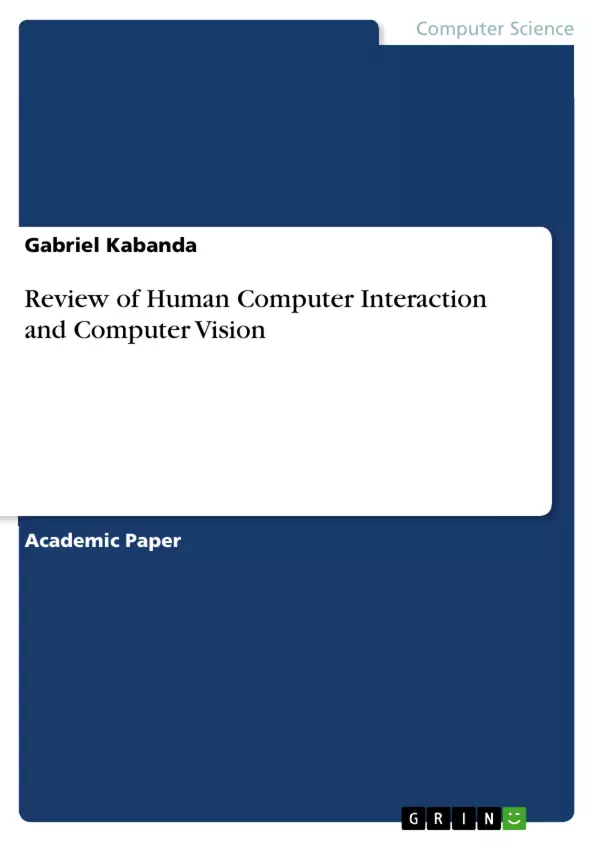This review describes or analyses the trends and best practices in Human Computer Interaction and Computer Vision. Human-Computer Interaction (HCI) is a computer user interface which the user of the system works with to achieve their given tasks and sees the system in use. Information Technology (IT) is essentially an integrated person-machine system that provides information support operations, management and decision-making. Human Computer Interaction (HCI) focuses on the interactions between human and computer systems to achieve the IT system functionality, user experience, usability, the support of user interaction effectiveness. Users are increasingly preferring the use of online business systems and so are becoming intolerant of systems which are not user friendly. The human factor is an attribute (physical or cognitive) which is specific to people that use a system and how it influences the normal operations of the system as well as the achievement of human-environment equilibriums.
Surface technology eliminates input/output devices through a touch sensitive feature which plays the role of input/output devices as a result of the merger between the physical and the virtual world. Through surface technology, the user eliminates the use of GUI mediums and reduces the gap between the physical and the virtual world.There are two classes of surface technology, one for the display and the other one which uses a touch sensitive mechanism for the interpretation of user signals. New approaches and methods are now needed in HCI to equip researchers with a better understanding of designing interactive systems. There are new interactive possibilities to be explored in audio-based mobile technology. The increasing popularity of smartphones has proved the portability, adaptability and ‘always on’ capability of geo-locative interactive systems. HCI bridges the gap between humans and computing devices with respect to observation of interactions, analysis of the involved interactions and the the human consequences of the interaction. The focus of HCI is the practice of usability which includes look-and-feel features, appeal, utility, efficiency, effectiveness and safety.
Inhaltsverzeichnis (Table of Contents)
- ANALYTICAL EXPOSITION
- CRITICAL CONTEXT
- INTEGRATIVE CONCLUSION
Zielsetzung und Themenschwerpunkte (Objectives and Key Themes)
This paper provides an analysis of current trends and best practices in Human-Computer Interaction (HCI) and Computer Vision. It explores how HCI strives to bridge the gap between humans and computing devices, focusing on the design and evaluation of user interfaces for optimal user experience and effectiveness.
- Evolution and trends in Human-Computer Interaction
- Role and significance of user interfaces in IT systems
- Impact of surface technology on user interaction
- Design principles for user-centered interfaces
- Integration of Computer Vision into human-computer interaction
Zusammenfassung der Kapitel (Chapter Summaries)
ANALYTICAL EXPOSITION
This chapter delves into the fundamental concepts of Human-Computer Interaction (HCI), highlighting its focus on achieving IT system functionality, user experience, usability, and interaction effectiveness. It explores the importance of user-friendliness in online business systems, discussing the three most commonly used user interfaces: the Graphical User Interface (GUI), the Voice User Interface, and the Multi-Modal Interface. The chapter then introduces surface technology, a revolutionary approach that eliminates input/output devices through touch-sensitive features, bridging the gap between the physical and virtual worlds. It discusses the various methods used in HCI research, emphasizing the multidisciplinary nature of the field and its integration of research methods from various disciplines.
CRITICAL CONTEXT
This chapter examines the critical context of HCI, highlighting its multidisciplinary nature and its role in designing and evaluating the technical affordance of computing devices. It explores the principles of HCI design, emphasizing the importance of understanding the target user and their needs, as well as the task being accomplished through the interactive system. The chapter then delves into the evolution of the user interface, focusing on the direct manipulation mode and its role in shaping the current generation of computer interfaces, the "Windows, Icons, Menus and Pointers" (WIMP) generation. The chapter also discusses the potential of Computer Vision to revolutionize human-computer interaction by providing a natural and intuitive communication between humans and machines. Finally, it explores new opportunities presented by mobile technologies and communication infrastructure for mobile audio input/output mechanisms, emphasizing the potential of sound in mobile interactions.
Schlüsselwörter (Keywords)
The primary focus of this paper centers around Human-Computer Interaction (HCI), Computer Vision, Graphical User Interface (GUI), WIMP, Voice User Interface, surface technology, human factor, usability, and functionality. These keywords encapsulate the core concepts and research areas explored within the context of designing and optimizing human-computer interaction.
- Quote paper
- Professor Gabriel Kabanda (Author), 2019, Review of Human Computer Interaction and Computer Vision, Munich, GRIN Verlag, https://www.hausarbeiten.de/document/497313


